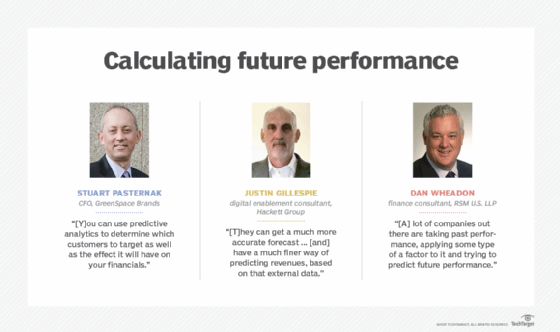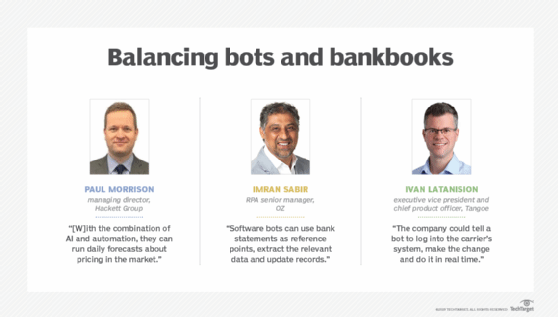
Fotolia
Financial tools for business breathe life into transaction data
No longer limited to simply crunching numbers, today's financial technologies can transform customer transaction data into improved operations, product development, CXs and ROIs.
The role of finance is changing. No longer does business finance center on someone in the back office pushing papers and recording transactions.
"It's the ability to understand the transaction, understand who your buyer is and who your suppliers are, and understand the predictability of them and understand what your cost factors are or what your risk factors are. It's the ability to predict that," said Stuart Pasternak, CFO at GreenSpace Brands, an organic and natural food company in Toronto. As a result, CFOs must act more like general managers with a vision toward the future, he added.
"CFOs need to know what's going on today, so they can make the appropriate decisions today, so they're ahead of the curve and can deal with those issues before they become problematic," he explained. That's where newer financial tools for business, such as artificial intelligence, machine learning, predictive analytics and robot process automation, come into play.
CFOs, for example, can use AI to mine collected supply chain data and derive insights into a company's buying trends. "Who's buying, what they're buying, what margins they're buying at. How much time is spent dealing with a [particular client]. What your cost structure is," Pasternak said. "And you can use that information to hone in on the best ways to improve results."
Identifying and lowering risk
In the collections process, AI is being used to better segment the late payers for a particular collection period, said Paul Morrison, managing director at the consultancy Hackett Group. "So, using AI, looking at the total history of collections or late-payment data, the software is able to identify the high-risk, nonpayers, and use that information to focus the human team on interacting with that high-risk group," he explained. "And the net outcome is improving cash flow because you're focusing efforts of the team on exactly where it's needed in that collections process, rather than chasing in a less guided way."
The Hackett Group is currently working with a manufacturing company whose forecasting team can't keep up with the complexity of predicting when to buy key inputs, Morrison said. "They spend tens of millions of dollars on their key inputs for their manufacturing process, and there's just so much data. They don't know what to do with it," he said. "They just cannot handle it. But with the combination of AI and automation, they can run daily forecasts about pricing in the market, and AI tells them when the best time is to buy the commodity."
Another company, which manages solar and wind farms for major U.S. utilities, receives data every five minutes on potential wind patterns and wind usage for the wind turbines. "Now they're going to use AI because, before, they couldn't have a human downloading data every five minutes to make a forecast," Hackett Group principal for digital enablement services Justin Gillespie said. "They're using automation to go out and grab that data and merge it with weather data so they can get a much more accurate forecast into what the potential output of these wind turbines is going to be. So they'll have a much finer way of predicting revenues, based on that external data."
Predicting business outcomes
Predictive analytics is among the financial tools for business playing an increasing role in corporate planning. "Predictive analytics can identify a pattern and an outcome in the past," said Imran Sabir, senior manager of robotic process automation (RPA) at digital consultancy OZ. "Using clean data, it can predict future outcomes based on identified patterns, thus preparing companies to plan and correct conditions for the best business outcome. For finance, it can improve profit, revenue growth, operational efficiency and net cash flow."
That means looking at key predictive drivers. "I think if you look historically, ... a lot of companies out there are taking past performance, applying some type of a factor to it and trying to predict future performance based on history," said Dan Wheadon, a finance and accounting practice lead at auditing and tax firm RSM U.S. LLP.

"You can look at what the cost is to do something," Pasternak added, "and use predictive analytics to determine the future cost by looking at customers' buying habits at different times of the year. Then you can predict, depending on the type of customers you have, what your inventory levels should be. If you're going to run a special, you can use predictive analytics to determine which customers to target as well as the effect it will have on your financials."
Predictive analytics can also figure into improving customer experience, product quality, business operations and eventually the bottom line, according to Ivan Latanision, executive vice president and chief product officer at enterprise expense management software provider Tangoe. "It could be improved customer service, or maybe you're going to deliver better quality products," he said. "But you could use predictive analytics as a way to look at the operational processes, the cost, the people, the changes you're going to make and forecast out what that would do to improve quality and [consequently revenue]."
Automating analytics and operations
Machine learning can be used to help identify patterns in data and predict what to expect in the future and can further adjust other variables to suggest how the best outcome can be achieved, Sabir said, offering this hypothetical: "Past sales data shows that, on any given sale, if prices are reduced by 10%, there was an increase in sales by 20%, compared to the same period without any sale, for a net margin of 40%. But if prices are reduced by 15%, there is an increase of 25% in sales, but net margin dropped to 38%."
Looking at this historic data, he added, analytics can predict the outcome if sale prices are reduced by 12%. Machine learning can suggest the best outcome by trying different sale price percentages.
Sabir called machine learning specific in nature, using different algorithms like decision trees and neural networks to mimic the way humans learn, while AI is more general and can learn a pattern in one specific data set and apply the same pattern recognition to other data sets. AI, he said, can be especially helpful in a company's financial health planning.
In addition, financial tools for business, such as RPA, are being applied to automating accounts payable and receivable, compliance and reporting on the way to more efficient and profitable operations, according to Sabir. The customer renewal process is generally a complex process, he said, mainly due to the number of operations and synchronization between different departments and systems.
"RPA can take over the entire process [and speed renewals]," Sabir said. "It can standardize communication with the client, help process changes and draft documents. Furthermore, it can update the internal systems accordingly."

Bots can also help maintain data consistency. "Customer information is constantly changing," Sabir noted. "For example, their names, their addresses or their credit scores. Software bots can use bank statements as reference points, extract the relevant data and update records, limiting the amount of manual work [by] the finance department."
Companies could also tie RPA together with other financial tools for business like machine learning, Latanision added. "Say you're looking at the usage of smartphones in your company, and you realize that the usage is coming in higher than you expected," he conjectured. "And your analytics engine provides a recommendation. It says, 'Go to the carrier and make this change today.' The company could tell a bot to log into the carrier's system, make the change and do it in real time. So you're using the technology to identify something that you could change that could control your costs."
Bottom line is financial tools for business can provide companies with multiple options in streamlining traditional functions and deriving insights that improve operations. Companies need to think things through holistically and understand from start to finish how to apply the right financial technologies so they can extract data from the source of a transaction and use it to predict future performance.






